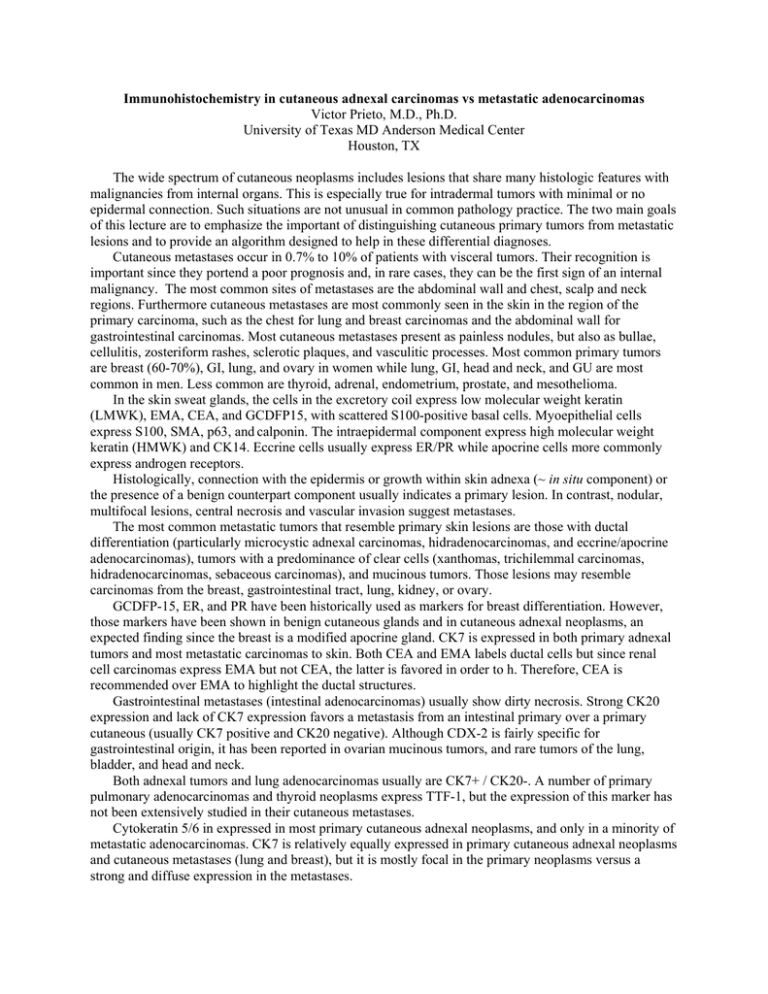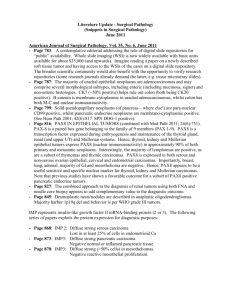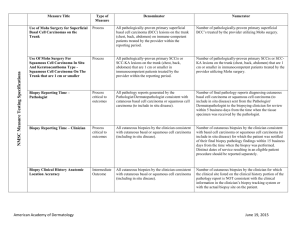Immunohistochemistry in cutaneous adnexal carcinomas vs
advertisement

Immunohistochemistry in cutaneous adnexal carcinomas vs metastatic adenocarcinomas Victor Prieto, M.D., Ph.D. University of Texas MD Anderson Medical Center Houston, TX The wide spectrum of cutaneous neoplasms includes lesions that share many histologic features with malignancies from internal organs. This is especially true for intradermal tumors with minimal or no epidermal connection. Such situations are not unusual in common pathology practice. The two main goals of this lecture are to emphasize the important of distinguishing cutaneous primary tumors from metastatic lesions and to provide an algorithm designed to help in these differential diagnoses. Cutaneous metastases occur in 0.7% to 10% of patients with visceral tumors. Their recognition is important since they portend a poor prognosis and, in rare cases, they can be the first sign of an internal malignancy. The most common sites of metastases are the abdominal wall and chest, scalp and neck regions. Furthermore cutaneous metastases are most commonly seen in the skin in the region of the primary carcinoma, such as the chest for lung and breast carcinomas and the abdominal wall for gastrointestinal carcinomas. Most cutaneous metastases present as painless nodules, but also as bullae, cellulitis, zosteriform rashes, sclerotic plaques, and vasculitic processes. Most common primary tumors are breast (60-70%), GI, lung, and ovary in women while lung, GI, head and neck, and GU are most common in men. Less common are thyroid, adrenal, endometrium, prostate, and mesothelioma. In the skin sweat glands, the cells in the excretory coil express low molecular weight keratin (LMWK), EMA, CEA, and GCDFP15, with scattered S100-positive basal cells. Myoepithelial cells express S100, SMA, p63, and calponin. The intraepidermal component express high molecular weight keratin (HMWK) and CK14. Eccrine cells usually express ER/PR while apocrine cells more commonly express androgen receptors. Histologically, connection with the epidermis or growth within skin adnexa (~ in situ component) or the presence of a benign counterpart component usually indicates a primary lesion. In contrast, nodular, multifocal lesions, central necrosis and vascular invasion suggest metastases. The most common metastatic tumors that resemble primary skin lesions are those with ductal differentiation (particularly microcystic adnexal carcinomas, hidradenocarcinomas, and eccrine/apocrine adenocarcinomas), tumors with a predominance of clear cells (xanthomas, trichilemmal carcinomas, hidradenocarcinomas, sebaceous carcinomas), and mucinous tumors. Those lesions may resemble carcinomas from the breast, gastrointestinal tract, lung, kidney, or ovary. GCDFP-15, ER, and PR have been historically used as markers for breast differentiation. However, those markers have been shown in benign cutaneous glands and in cutaneous adnexal neoplasms, an expected finding since the breast is a modified apocrine gland. CK7 is expressed in both primary adnexal tumors and most metastatic carcinomas to skin. Both CEA and EMA labels ductal cells but since renal cell carcinomas express EMA but not CEA, the latter is favored in order to h. Therefore, CEA is recommended over EMA to highlight the ductal structures. Gastrointestinal metastases (intestinal adenocarcinomas) usually show dirty necrosis. Strong CK20 expression and lack of CK7 expression favors a metastasis from an intestinal primary over a primary cutaneous (usually CK7 positive and CK20 negative). Although CDX-2 is fairly specific for gastrointestinal origin, it has been reported in ovarian mucinous tumors, and rare tumors of the lung, bladder, and head and neck. Both adnexal tumors and lung adenocarcinomas usually are CK7+ / CK20-. A number of primary pulmonary adenocarcinomas and thyroid neoplasms express TTF-1, but the expression of this marker has not been extensively studied in their cutaneous metastases. Cytokeratin 5/6 in expressed in most primary cutaneous adnexal neoplasms, and only in a minority of metastatic adenocarcinomas. CK7 is relatively equally expressed in primary cutaneous adnexal neoplasms and cutaneous metastases (lung and breast), but it is mostly focal in the primary neoplasms versus a strong and diffuse expression in the metastases. Podoplanin (D2-40) appears to be mostly positive in adnexal tumors but not in metastatic adenocarcinomas. In our opinion, p63 is one of the most helpful markers. It is routinely expressed by cutaneous epidermal and glandular basal cells, and in myoepithelial cells and in transitional, prostate, and respiratory epithelia. p63 is expressed in trichilemmal, eccrine, and apocrine cutaneous adnexal tumors in more than 25% of the cells (not in mucinous ones, which are negative) but it is not expressed in most metastatic adenocarcinomas to skin (breast, lung or GI). The only exception of breast carcinoma that routinely expresses p63 is high grade, myoepithelial carcinoma, but those lesions do not resemble the common, well to moderately differentiated cutaneous adnexal carcinoma. Also supporting the usefulness of p63, metastasis of cutaneous adenocarcinomas maintain their p63 expression Primary mucinous adenocarcinoma of the skin is morphologically indistinguishable from metastasis (GI, breast and ovary). Immunohistochemically, all these lesions express CK7; only GI adenocarcinomas express CK20, which may be helpful as a distinction from primary skin mucinous adenocarcinomas. Furthermore, p63 may be helpful to distinguish primary from metastatic lesions, since it may highlight the presence of myoepithelial cells in sweat glands partially occupied by adenocarcinoma cells, thus consistent with an in situ component and a primary lesion. Regarding tumors with clear cell histology, sebaceous carcinomas usually present at least focal scalloping of the nuclei. These cells are positive for EMA and adipophilin; however it is important to notice that adipophilin can be positive also in macrophages so, in order to be considered positive, it has to label the vacuoles of the tumor cells. CD10 is only relatively helpful since it is expressed by both renal cell carcinomas and skin lesions (sebaceous, balloon cell nevi, and xanthomas). The renal cell carcinoma antigen (RCC-Ma) is fairly specific for clear cell renal cell carcinoma (80-85% of primary clear cell renal carcinomas). In general, positive RCC-Ma is highly suggestive of metastatic renal cell carcinoma while negative CD10 should be considered inconsistent with a renal cell carcinoma. Immunohistochemical summary Adenocarcinomas (ductal differentiation): Primary cutaneous: - In situ component (p63 in normal cells) - Diffuse (>25%) p63 expression by tumor cells - Podoplanin+ - CK7+/CK20Metastasis: - GI: CK7/20 +, cdx2+ - CK5/6- (adenocarcinomas) - p63/podoplanin- Breast may be mammoglobin + Clear cell neoplasms: Primary: - RCC-Ma-/CD10-(+) - Sebaceous lesions are EMA and adipophilin+ (vacuoles) Metastasis: - Renal: RCC-Ma+(-)/CD10+ Selected references 1. Avery AK, Beckstead J, Renshaw AA, et al. Use of antibodies to RCC and CD10 in the differential diagnosis of renal neoplasms. Am J Surg Pathol. 2000;24:203-10. 2. Bahrami S, Malone JC, Lear S, et al. CD10 expression in cutaneous adnexal neoplasms and a potential role for differentiating cutaneous metastatic renal cell carcinoma. Arch Pathol Lab Med. 2006;130:1315-9. 3. Bhargava R, Beriwal S, Dabbs DJ. Mammaglobin vs GCDFP-15: an immunohistologic validation survey for sensitivity and specificity. Am J Clin Pathol. 2007 Jan;127(1):103-13 1. Ivan D, Diwan AH and Prieto VG. Expression of p63 in primary cutaneous adnexal neoplasms and adenocarcinoma metastatic to the skin. Mod Pathol. 2005;18:137-42. 2. Ivan D, Nash, JW, Prieto, VG, et. al. Use of p63 expression in distinguishing primary and metastatic cutaneous adnexal neoplasms from metastatic adenocarcinoma to skin. J Cutan Pathol. 2007;34:474-480. 3. Kazakov DV, Suster S, LeBoit PE, et al. Mucinous carcinoma of the skin, primary and secondary: a clinicopathologic study of 63 cases with emphasis on the morphologic spectrum of primary cutaneous forms: homologies with mucinous lesions of the breast. Am J Surg Pathol 2005; 29(6): 764. 4. Liang H, Wu H, Giorgadze Ta, et al. Podoplanin is highly sensitive and specific marker to distinguish primary adnexal carcinomas from adenocarcinomas metastatic to skin. Am J Surg Pathol 2007;31(2):304-310 5. McGregor DK, Khurana KK, Cao C, et al. Diagnosing primary and metastatic renal cell carcinoma: the use of the monoclonal antibody 'Renal Cell Carcinoma Marker'. Am J Surg Pathol. 2001;25:1485-92. 6. Perna AG, Smith MJ, Krishnan B, et al. CD10 is expressed in cutaneous clear cell lesions of different histogenesis. J Cutan Pathol. 2005;32:348-51. 7. Perna AG, Ostler, D. A., Ivan, D., et. al. Renal cell carcinoma marker (RCC-Ma) is specific for cutaneous metastasis of renal cell carcinoma. J Cutan Pathol. 2007;34:381-385. 8. Plumb SJ, Argenyi, ZB, Stone, MS, et. al. Cytokeratin 5/6 immunostaining in cutaneous adnexal neoplasms and metastatic adenocarcinoma. Am J Dermatopathol. 2004;26:447-51. 9. Prieto VG, Kenet BJ and Varghese M. Malignant mesothelioma metastatic to the skin, presenting as inflammatory carcinoma. Am J Dermatopathol. 1997;19:261- 5. 10. Qureshi HS, Ormsby AH, Lee MW, et al. The diagnostic utility of p63, CK5/6, CK 7, and CK 20 in distinguishing primary cutaneous adnexal neoplasms from metastatic carcinomas. J Cutan Pathol. 2004;31:14552. 11. Wallace ML, Longacre TA and Smoller BR. Estrogen and progesterone receptors and anti-gross cystic disease fluid protein 15 (BRST-2) fail to distinguish metastatic breast carcinoma from eccrine neoplasms. Mod Pathol. 1995;8:897- 901.


